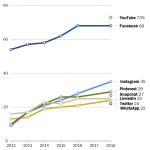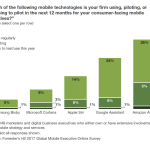Report: 93 percent of brands and retailers misaligned, harming omnichannel efforts
Brands are spending to drive offline sales, but not partnering with retailers or properly measuring the in-store impact of digital.

Omnichannel is both an overused buzzword and perhaps, in idealized form, an unattainable goal. In its simplest formulation, it’s an effort to deliver consistent brand and shopping experiences to the consumer across platforms, devices and stores. It also connotes a 360-degree understanding of the customer.
In a new survey and report from Netsertive and the CMO Council, “189 senior marketing leaders with organizations that currently sell products through a physical retail channel” were asked about their omnichannel strategies. Though this isn’t made explicit in the document, respondents are brands that sell primarily through third-party retailers (e.g., appliance brand that sells via third-party appliance retailer).
Asked which media channels are most critical, these survey respondents said:
- Digital advertising (generally) — 60 percent
- Corporate websites — 56 percent
- Mobile — 54.4 percent
- Social media channels — 51.2 percent
- Email — 47.2 percent
- Local in-store engagement and promotions — 40 percent
- Live events — 24.8 percent
- Local retail partners and resellers — 22.4 percent
- Television advertising — 21.6 percent
- Digital video — 19.2 percent
- Traditional print advertising — 19.2 percent
- Direct mail or printed inserts — 16 percent
- Radio advertising — 8.8 percent
- Partner websites and social channels — 8 percent
The overwhelming majority of respondents (94 percent) said that omnichannel “is either important or critical to reaching their business goals.” Indeed, these brands need drive people into physical stores to buy their products. Yet there’s ambivalence (or ignorance) about the importance of coordinating digital and offline retail experiences: “88 percent of brands don’t consider local retail partners to be a critical ally in achieving business outcomes.”
One of the primary findings in the document is that available measurement tools are not being utilized. For example, the report finds less than 25 percent of brand respondents are using tools such as Google Store Visits, FourSquare or LiveRamp to measure the impact of digital on offline commerce.
Netsertive argues that despite the ambition and effort to drive in-store visits and sales, the omnichannel breakdown for brands often comes in the last mile because brands and retailers are effectively not aligned:
[M]arketers are struggling to align strategies with their local retail partners. In fact, only seven percent of marketers believe they are fully aligned with local partners, feeling that both brand and retail partners are in lock step with seamlessly executed brand campaigns.

Brands are spending money to drive in-store visits and engagement. Simultaneously, budget and media planning decisions are being made on the basis of perceived ROI. However, brands may not have an accurate picture of ROI if they’re not properly measuring offline behavior:
As noted earlier, 42 percent of marketers admit they are struggling to measure the impact of digital marketing efforts specific to their ability to drive in-store sales and engagements. And, while 23 percent are using third-party tools like Google Store Visits or FourSquare Attribution, few measurement options are in play, with only three percent tracking e-receipts, six percent tracking in-store redemption of promotional offers delivered via digital channels, and 10 percent tracking digital coupon redemption.
The document also faults brands for wanting to exercise too much control over media and not putting the consumer first in the omnichannel process, which is ironic, since that’s what omnichannel, by definition, is supposed to be about. The report goes on to make the following general recommendations to brands (I’ve paraphrased them):
- Think beyond the digital channels you can measure and control today.
- Consider the impact that a cohesive brand-to-local marketing strategy could have on bridging the gap in the customer experience.
- Overlooking local retail as a critical element of an omnichannel strategy will result in lost customers and sales.
- Focus on customers’ purchasing behaviors to better align digital and physical elements of an omnichannel strategy.
Marketing Land – Internet Marketing News, Strategies & Tips
(22)















